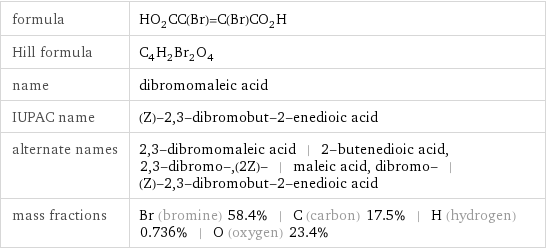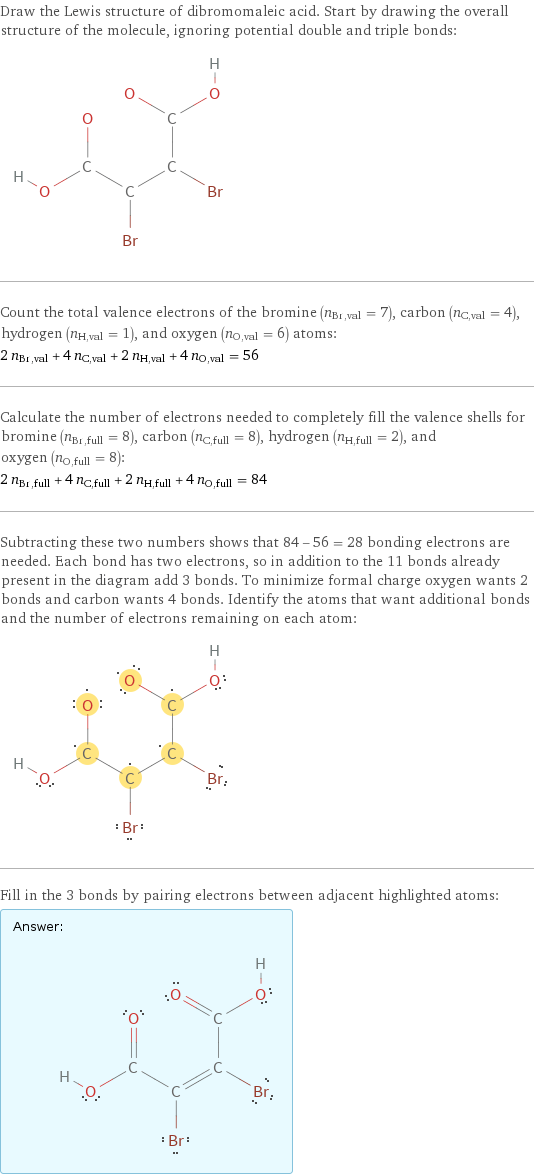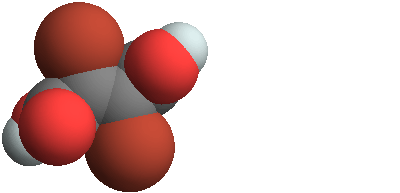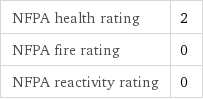Input interpretation

dibromomaleic acid
Chemical names and formulas

formula | HO_2CC(Br)=C(Br)CO_2H Hill formula | C_4H_2Br_2O_4 name | dibromomaleic acid IUPAC name | (Z)-2, 3-dibromobut-2-enedioic acid alternate names | 2, 3-dibromomaleic acid | 2-butenedioic acid, 2, 3-dibromo-, (2Z)- | maleic acid, dibromo- | (Z)-2, 3-dibromobut-2-enedioic acid mass fractions | Br (bromine) 58.4% | C (carbon) 17.5% | H (hydrogen) 0.736% | O (oxygen) 23.4%
Lewis structure

Draw the Lewis structure of dibromomaleic acid. Start by drawing the overall structure of the molecule, ignoring potential double and triple bonds: Count the total valence electrons of the bromine (n_Br, val = 7), carbon (n_C, val = 4), hydrogen (n_H, val = 1), and oxygen (n_O, val = 6) atoms: 2 n_Br, val + 4 n_C, val + 2 n_H, val + 4 n_O, val = 56 Calculate the number of electrons needed to completely fill the valence shells for bromine (n_Br, full = 8), carbon (n_C, full = 8), hydrogen (n_H, full = 2), and oxygen (n_O, full = 8): 2 n_Br, full + 4 n_C, full + 2 n_H, full + 4 n_O, full = 84 Subtracting these two numbers shows that 84 - 56 = 28 bonding electrons are needed. Each bond has two electrons, so in addition to the 11 bonds already present in the diagram add 3 bonds. To minimize formal charge oxygen wants 2 bonds and carbon wants 4 bonds. Identify the atoms that want additional bonds and the number of electrons remaining on each atom: Fill in the 3 bonds by pairing electrons between adjacent highlighted atoms: Answer: | |
3D structure

3D structure
Basic properties

molar mass | 273.86 g/mol phase | liquid (at STP) melting point | 125 °C boiling point | 363 °C solubility in water | very soluble
Units

Chemical identifiers

CAS number | 608-37-7 Beilstein number | 1724799 PubChem CID number | 2723896 PubChem SID number | 24849019 SMILES identifier | C(=C(C(=O)O)Br)(C(=O)O)Br InChI identifier | InChI=1/C4H2Br2O4/c5-1(3(7)8)2(6)4(9)10/h(H, 7, 8)(H, 9, 10)/b2-1-/f/h7, 9H MDL number | MFCD00004207
NFPA label

NFPA label

NFPA health rating | 2 NFPA fire rating | 0 NFPA reactivity rating | 0